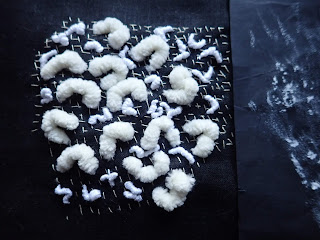With the vast amount of rubbings I made, I chose the ones that most appealed to me.
The samples were done on black linen stretched in an embroidery hoop. I only looked at the rubbing and not at the photograph for inspiration.
Sample 10a: the stitches done here were very very long fly stitches executed with a fine thread. More stitches were added by turning the sample upside down. When I took the sample out of the hoop I noticed that the stitches were quite "loose" because they were too long. Here a light interfacing ironed on the back solved the problem.
Sample b: The stitches were done in a thicker wooly thread using a blanket stitch with variations in size and direction. The stitch was worked in both directions to form irregular squares. Filler stitches were added with fine thread in bokhara couching to reproduce the background "noise" of the rubbing.
Sample 10c: who would have thought that this paper sample produced this rubbing. I only found out when I added the pictures to the blog.
I saw fly stitches here.In the fabric sample these were done with a double thread of different whites in the needle. A set of 2 stitches were done joining in the stem which was then wrapped with a blanket stitch . Filler stitches were done with a doubled fine thread and these stitches were left a bit loose.
Sample 10d: This sample was done in the Litch Stitch which I absolutely love. Here it wasn't used to build up a lot of texture but to form little "worms". They were done with a chenille type knitting yarn and then with cotton floss. The background was covered with little straight stitches.
Sample 10e: The translation into stitch from the picture is quite obvious. The strong "V" shape was done with irregular bullion knots to form the shape. Then fly stitches in fine thread were added. These were done in from all directions so that it is hardly visible which stitch has been used.
















